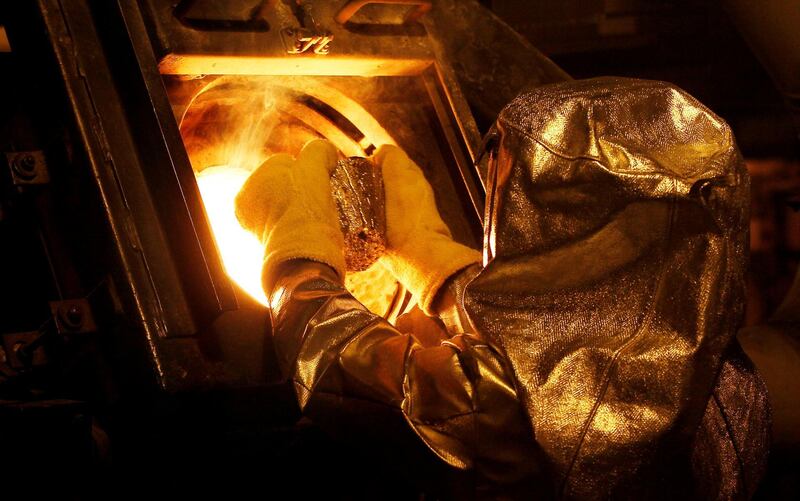Last week the US Federal Reserve hit the pause button on further interest rate increases and promised a ‘patient approach’ to future rises. Gold prices immediately jumped to $1,320 and silver slipped back over $16 an ounce.
But sentiment towards gold took a decidedly bullish turn in the fourth quarter of last year with the gold price up 7.5 per cent and gold mining shares up 12.6 per cent, while the S&P 500 index of US stocks slumped 13.5 per cent.
Stock markets have rallied in 2019. But gold has continued its price advance, with the Federal Reserve all but admitting that its last interest rate increase in December was a mistake.
Head of commodities research at Goldman Sachs, Jeffrey Currie, says ‘long gold’ is his favourite commodities trade for 2019 with $1,450 an ounce his price target. Other analysts are more cautious, although gold prices bottomed out at $1,050 just over two years ago.
Recessionary fears about trade wars and Brexit, consumer price inflation and central bank buying are all reasons to be positive about bullion, Mr. Currie argues. Technical chartists also see a bullish head-and-shoulders bottom in the gold chart that is confirmed by a double-bottom for silver prices.
An end to rising interest rates would be a key catalyst for gold that pays no interest and gets penalised for not doing so when interest rates are rising.
In 1989, 2000 and 2007, the first pause in rate rises by the Federal Reserve flagged an imminent recession and an easing of rates within six months. History could be about to repeat itself.
Gold is a safe haven asset in troubled global financial markets, and stocks, bonds and real estate have all come under pressure over the past few months. By default, perhaps, it is gold’s turn to shine.
Indeed, gold has already been outperforming other asset classes across the board, especially in non-dollar currencies where it is at an all-time high in more than 70 currencies. The weakening US dollar is just a late joiner to this growing club.
So if you are bullish on gold for 2019, how should you invest?
Buying a few coins in the UAE’s gold souks is not a bad plan. These are very competitive markets, so you won’t be overcharged and they have a reputation for honesty.
But if you want to assemble a precious metals portfolio then a more sophisticated approach is required. For most significant investors this entails a pyramid of risk.
Starting from the bottom, the lowest risk is to hold actual physical gold either as coins, or more conveniently and safely in an exchange traded fund held in an Internet brokerage account.
However, you will pay fees for ETF management and custody. These can mount up if you end up holding on to gold for years, rather than months. But it is very simple to buy and sell online.
The two lowest cost gold ETFs are SPDR Gold MiniShares Trust (GLDM) and GraniteShares Gold Trust (BAR), with annual fees of 0.18 and 0.2 per cent respectively.
Another way to hold gold with no fees at all is an unallocated gold account at the Perth Mint in Australia, a government-owned institution with a AAA-rating.
Having established a base in physical gold, often the next step is to diversify with silver. The shiniest monetary metal has a 90 per cent correlation to the direction of gold. But due to its relative scarcity, silver increases by twice the rate of gold in a rising market (and falls twice as fast too).
Gold is presently 80 times more valuable than silver so holding the physical metal is going to require a lot more storage space. Again, the best option is an ETF. Sprott Physical Silver Trust (PSLV), for example, is a reputable choice.
Now you can move to the next level of risk: owning the shares of gold and silver producers. As the price of these metals goes up the profits made by the companies that dig them out of the ground rise even faster, as their fixed costs stay the same.
Many investors choose to buy an ETF holding a basket of these shares to avoid individual company risk. The VanEck Vectors Gold Miners ETF (GDX) is the best known for larger gold companies, and Global X Silver Miners (SIL) for silver.
For the highest risk, and highest potential rewards, there are the so-called junior precious metal companies that usually combine smaller scale production with ownership of exploration prospects.
Again ETFs can, to some extent, hedge individual company risk. VanEck’s junior gold miners ETF (GDXJ) and the ETFMG Prime Junior Silver ETF (SILJ) are worth considering here, with the latter offering leverage against the silver price as well as increased mining profits.
Individual gold and silver companies may well offer greatly superior returns to these ETFs, and if gold prices continue to go up I would drill down to this level next.
Peter Cooper has been writing about finance in the Gulf for two decades







